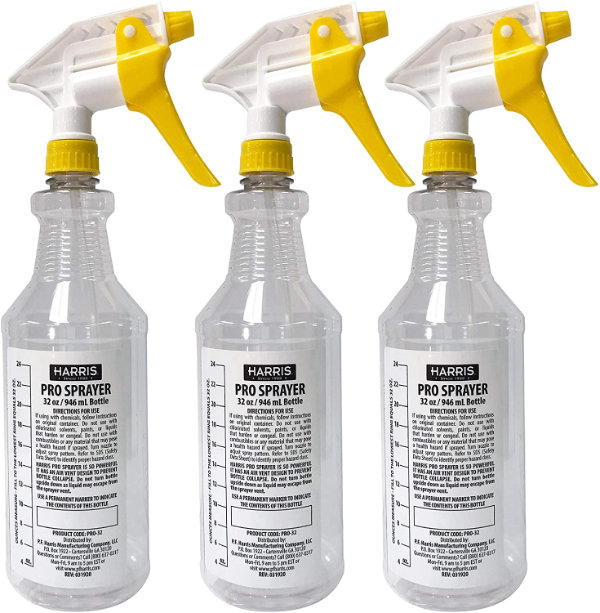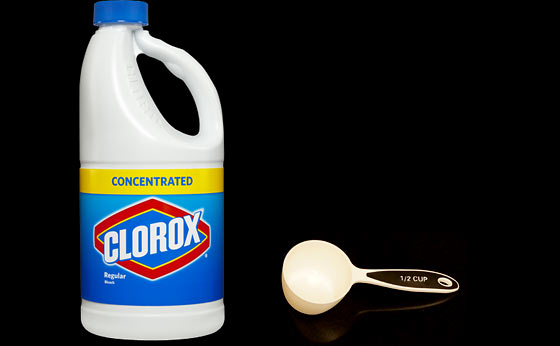Bleach Water Ratio For Disinfecting | Make Your Own Disinfectant
I have updated the bleach water ratio with guidelines from the CDC regarding COVID-19 Coronavirus. I’ve also included ratios for making 1 gallon, 1 quart, or 2 cups (convenient for a spray bottle).
Bleach is one of the most widely available and affordable disinfectants on earth. Clorox® brand liquid bleach was introduced in 1913 and has played a critical role in helping to protect public health by killing germs that cause illness.
(Disinfectant Bleach Water Ratio Listed Below)
– Non food surfaces
– Food contact surfaces
Bleach is commonly mixed with water for use as a disinfectant to kill germs that can make people sick. This includes MRSA, Staph, and Norovirus (among many others!).
Germs and viruses can thrive in the kitchen, bathroom, baby’s room, laundry room, especially around toilets, sinks, faucets and bathtubs.
The World Health Organization (WHO) and the Centers for Disease Control and Prevention (CDC) – recommend the use of bleach for controlling the spread of pathogens that can cause infections and other health threats.
Recommended bleach disinfectant ratio mixed with water for non-food surfaces and food contact surfaces:
CAUTION: Do not mix Clorox® Regular-Bleach with other household chemicals. Toxic fumes could result.
Bleach Water Ratio For Disinfectant (Non-Food Surfaces)
(NON-FOOD SURFACES)
– 2500 ppm chlorine mixture
For cleaning, sanitizing, and disinfecting surfaces such as bathtubs, sinks, faucets, tile, plastic toys, potty chairs, high chairs, changing tables, floors, appliances, countertops, garbage cans, walls, light switches, etc..
Note: This concentration is more than adequate for CDC guidelines of Covid-19 (or Delta). See below.
Pre-wash surface with detergent and water, then apply the sanitizing solution of bleach and water. Allow solution to contact surface for at least 5 minutes for optimum effectiveness. Afterward, rinse and-or air dry.
(Informational sources listed below)
(numbers are rounded)
This solution will be sourced from Regular Household Bleach that has a 6% Sodium Hypochlorite concentration and we will dilute it with water to make a 2,500 ppm concentration for disinfecting:
Dilution bleach to water ratio of 1:22
3/4 cup Clorox® Regular-Bleach / GALLON water
2-3/4 Tablespoons Clorox® Regular-Bleach / Quart (4 cups) water
4 teaspoons Clorox® Regular-Bleach / Pint (2 cups) water
Bleach to Water Ratio for For Spray Bottles:
These mixtures are the same concentration as listed above.
- 4 teaspoons with 16 ounces of water
- 6 teaspoons with 24 ounces of water
- 8 teaspoons with 32 ounces of water
32 Ounce Chemical Spray Bottles
Given the bleach to water ratio for spray bottles, consider the following heavy choices for your bleach disinfectant solution. (Cheaper nozzles will not withstand the bleach over time).
Heavy Duty Spray Bottles for Chemical solutions
HARRIS Pro 32-ounce
(view on amzn)

COVID-19 Coronavirus Disinfection with Bleach | CDC Recommendations
The Centers for Disease Control recommends a bleach water ratio which produces at least 1,000 ppm sodium hypochlorite.
Therefore the formulas listed ^^above (2,500 ppm) are more than adequate.
Minimum bleach water ratio for Coronavirus:
“Diluted household bleach solutions (at least 1,000 ppm sodium hypochlorite) can be used if appropriate for the surface. Follow manufacturer’s instructions for application, ensuring a contact time of at least 1 minute, and allowing proper ventilation during and after application.”
~ CDC
“Check to ensure the product is not past its expiration date. Never mix household bleach with ammonia or any other cleanser. Unexpired household bleach will be effective against coronaviruses when properly diluted.”
Prepare a bleach solution by mixing:
~ CDC (source document)
5 tablespoons (1/3 cup) bleach per gallon of water or
4 teaspoons bleach per quart of water
Bleach Water Ratio For Disinfectant (Food Contact Surfaces)
(FOOD CONTACT SURFACES)
– 200 ppm chlorine mixture
For cleaning food handling equipment and food contact surfaces such as plastic cutting boards*, stainless cutlery, dishes, glassware, pots and pans, stainless utensils, pet bowls, teething rings,
Pre-wash surface with detergent and water. Then soak with the sanitizing solution of bleach and water. Allow solution to contact surface for at least 2 minutes for optimum effectiveness. Drain and air dry.
(Informational sources listed below)
(numbers are rounded)
This solution will be sourced from Regular Household Bleach that has a 6% Sodium Hypochlorite concentration and we will dilute it with water to make a 200 ppm concentration for disinfecting:
Dilution bleach to water ratio of 1:285
2-3/4 teaspoons Clorox® Regular-Bleach / GALLON water
3/4 teaspoon Clorox® Regular-Bleach / Quart (4 cups) water
1/3 teaspoon Clorox® Regular-Bleach / Pint (2 cups) water
I have a pair of these for when mixing larger batches of bleach (in a gallon bucket for example). It’s just a good thing to have a pair in general:
HEAVY DUTY PVC CHEMICAL GLOVES (Wells Lamont)
>> Heavy Duty PVC Chemical Gloves
(view on amzn)
NOTE: This is NOT (NOT!) the formula for drinking water purification. Rather it is much stronger for disinfecting surfaces.
For drinking water purification, read the following articles:
[ Read: Make Drinking Water Safe With Bleach ]
[ Read: Bleach – Water Ratio For Drinking Water Purification ]
CAUTION: Do not mix Clorox® Regular-Bleach with other household chemicals. Toxic fumes could result.
TIP: Bleach formula breaks down after awhile. For health care, day care, it is commonly recommended to make new formula in 24 hours.
NOTE: Bleach solutions may discolor fabrics (your clothes, carpets, etc..).
For disinfecting Ebola virus, read: “Ebola Virus Disinfection With Bleach“
UPDATE: Clorox has adjusted their concentration blend (sodium hypochlorite) over the years. They’ve gone from 5.25%, 6%, up to 8.25%, and now they’re apparently back to 6% (some apparently 7.5%). The formulas above presume using Regular Bleach with a 6% concentration. If you are using Regular Bleach with a higher concentration (e.g. 7.5%, 8.25%) applying the ratios above will simply result in a slightly more potent solution.
What is the difference between cleaning and disinfecting?
Cleaning removes dust and debris from a surface. Disinfecting kills a variety of germs including bacteria such as Staph, Salmonella and E. coli, the viruses such as influenza (the “flu” virus) and rhinovirus (one of the causes of the common cold) and the fungus that causes athlete’s foot. Disinfecting hard, nonporous surfaces is one of the most reliable ways to help lower the risk of spreading these germs from surfaces by touch.
Are disinfectants harmful to the environment?
No. During normal household use and disposal, bleach breaks down primarily into salt and water. Bleach does not contaminate ground water because it does not survive sewage treatment – neither in municipal sewage treatment plants nor in septic systems.
Why is bleach disinfectant so extremely important during a survival situation?
Without access to healthcare, an infection, if bad enough, can kill you. During a disaster or survival scenario, you are more vulnerable to cuts and injuries. These could become infected. Prior to the days of antibiotics and disinfection, many people commonly died from infection. Be sure to have an adequate supply of bleach in your supply of preparedness items, and remember that it has a shelf life of about 1 year.
Partial List of organisms that the proper Clorox bleach-to-water ratios can kill
Bacteria
Staphylococcus aureus (Staph.)
Salmonella choleraesuis
Pseudomonas aeruginosa
Streptococcus pyogenes (Strep.)
Escherichia coli O157:H7 (E. coli)
Shigella dysenteriae
Methicillin Resistant Staphylococcus aureus (MRSA)
Fungi
Trichophyton mentagrophytes (can cause Athlete’s Foot)
Candida albicans (a yeast)
Viruses
Rhinovirus Type 37 (a type of virus that can cause colds)
Influenza A (Flu virus)
Hepatitis A virus
Rotavirus
Respiratory Syncytial Virus (RSV)
HIV-1 (Human Immunodeficiency Virus)*
Herpes simplex Type 2
Rubella virus
Adenovirus Type 2
Cytomegalovirus
COVID-19 Coronavirus (see CDC source link above)
Sources:
– Oklahoma State University; Food & Agricultural Products Research & Technology Center
– University of California; UC Food Safety; PublicHealthOntario.ca
– Centers for Disease Control & Prevention
– Clorox
[ Read: How Much ‘ Pool Shock ‘ To Make Your Own Bleach Equivalent ]

